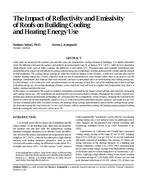Description
Dark roofs are heated by the summer sun and thus raise the summertime cooling demand of buildings. For highly absorptive roofs, the difference between the surface and ambient air temperatures may be as high as 50°C (90°F), while for less absorptive (high-albedo) roofs, such as white coatings, the difference is only about 10°C. Measured data and computer simulations have demonstrated the impact of roof albedo in saving cooling energy use in buildings. Savings depend on the climate and the amount of roof insulation. The cooling energy savings for reflective roofs are highest in hot climates. A reflective roof may also lead to a higher heating energy use. Clearly, reflective roofs are not recommended for cold climates where there is no need to cool the buildings. Simulations also indicate that roof emissivity can have a substantial effect on both heating and cooling energy use. In cold climates, a low-emissivity roof can add resistance to the passage of heat flow out of the building and result in savings in heating energy use. In cooling dominant climates, a low-emissivity roof will lead to a higher roof temperature and, hence, a higher cooling load from the roof. In this paper, we summarize the result of computer simulations and analyze the impact of roof albedo and emissivity on heating and cooling energy use. The simulations are performed for eleven representative climates throughout the country. Several residential and commercial prototypical buildings are considered for these simulations. In hot climates, changing the roof emissivity from 0.9 (emissivity of most nonmetallic surfaces) to 0.25 (emissivity of fresh and shiny metallic surfaces) can result in a net 10% increase in annual utility bills. In colder climates, the heating energy savings approximately cancel out the cooling energy penalties from decreasing the roof emissivity. In very cold climates with no summertime cooling, the heating energy savings resulting from decreasing the roof emissivity can be up to 3%.
AUTHOR: Hashem Akbari, Ph.D., Steven J. Konopacki
CITATION: Thermal Performance of the Exterior Envelopes of Buildings VII
KEYWORDS: December, Florida, 1998
YEAR: 1998
Citation: Thermal Performance of the Exterior Envelopes of Buildings VII
Product Details
- Published:
- 1998
- File Size:
- 1 file , 140 KB
- Product Code(s):
- D-8117




